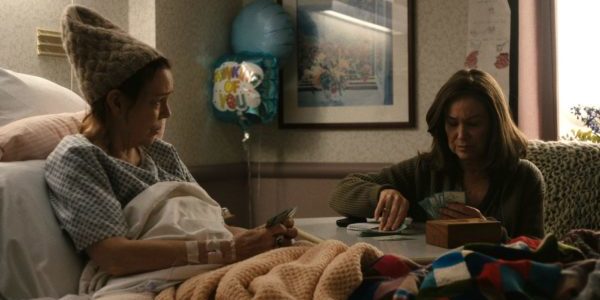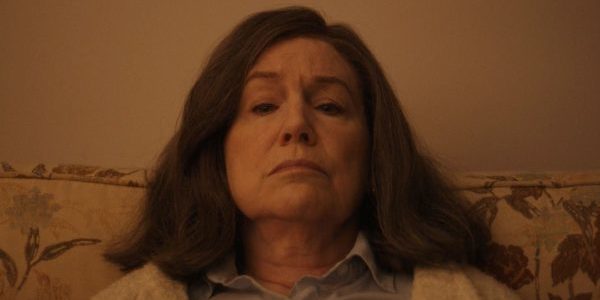DIANE: A Sluggish Study Of Servitude

Midwesterner, movie lover, cinnamon enthusiast.
The first fictional feature from film critic and New York Film Festival programmer Kent Jones, Diane, studies an aging Massachusetts woman (Mary Kay Place) who has dedicated her life to being of service. She volunteers at a homeless shelter, visits her dying cousin Donna in the hospital, and checks in on her drug-addicted adult son. We get the feeling Diane wouldn’t know what to do if she didn’t have someone to help; after all, the film opens with her making a to-do list.

The film is mostly contained within these few locations, with shots of Diane driving along wintry Massachusetts backroads acting as contemplative tendons. “I wanted it to be a film that followed the rhythm of living — as I experience it, and as loved ones that I’ve had experienced it,” the filmmaker told No Film School. As such, Diane moves through daily tasks without much expectation and side characters die off without any fanfare, as old people tend to do.
A Story about Shame
Slowly, through dialogue, Jones reveals a bit of our protagonist’s backstory: a couple decades ago, she ran off with Donna’s boyfriend, leaving her husband and son behind. It’s the type of personal mistake that many screenwriters might deem too slight, but Jones understands the power of lingering shame that such a moral misstep can have. Diane has tried to forgive herself, and seems to have dedicated her life to others in an attempt to tip the universe’s scales toward total atonement.

Of course, her fate is to never outrun the past, and both Donna and her son won’t let her. In a late clunky scene, her son, played by Jake Lacy (Carol, Obvious Child), admits that since Diane’s transgression, he’s programmed himself to be hostile and disagreeable toward her. Perhaps a better actor could’ve pushed this scene past Jones’ over pronounced screenplay, but Lacy, who is much more comfortable as the dorky khaki-and-boat-shoe love interest in Obvious Child, awkwardly waddles his way through this dime-a-dozen drug addict-cum-evangelical Christian.
The Struggle for Narrative Footing
The first thirty minutes is especially lumbering and light on characterization, though Place’s performance has depth. In the latter acts, Jones tries his hand at a couple divergent narrative methods, like the dream sequence where Diane gives over her arm to needle of presumably the same drug her son is addicted to.
“It’s a dream but that’s not very helpful but it’s not supposed to be helpful, it is a dream and you can put the dream logic together,” Jones told MUBI in an interview regarding the sequence. “But in a dream crazy things happen. Things you would deem to be crazy. Consider the fact that you’re taking care of someone who’s in and out of rehab, on and off the wagon, stopping and starting for years, but you never see them actually shooting up — the image is going to be in your mind. So is the sense of release.”

Perhaps Diane can only dream of release, but articulating it via a dream sequence of her shooting drugs is oddly cliched for a filmmaker whose criticism and programming would suggest a more interesting taste and instinct. Ultimately, Jones’ world building struggles to define itself as something more than an average, albeit thoughtful, indie film.
The ending is a flash-forward to Diane’s inevitable death, and even as she’s collapsing, we’re informed via overlapping voiceover, that she’s plagued by more she has to do, more things that need to checked off her to-do list. This final bit holds the precise conflict of Jones as a fiction filmmaker — a thoughtful sentiment in search of a more effective delivery. Telegraphing her internal monologue is the clumsy, moment-sapping touch of a filmmaker without the lexicon to do more with less.
Diane: Conclusion
This is obviously a personal film for Jones, who grew up in the same location and amongst the same milieu presented in Diane. When MUBI suggests the titular character is culled from his own mother, the filmmaker responds, “Here and there. But yes.” As someone with a mother who, like Diane, doesn’t know what to do with herself when not in service of others, it’s also a universal story, and one underrepresented in cinema — though not about a mother, Alfonso Cuarón’s Roma comes to mind.
And while Jones avoids the sort of de facto class condescension Cuarón’s film dips into, he could use some of Cuarón’s filmmaking agility to better convey the emotional wallop Diane’s story deserves.
What are your thoughts on Diane?
Diane was released in theaters March 29, 2019.
Does content like this matter to you?
Become a Member and support film journalism. Unlock access to all of Film Inquiry`s great articles. Join a community of like-minded readers who are passionate about cinema - get access to our private members Network, give back to independent filmmakers, and more.












